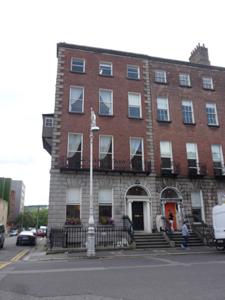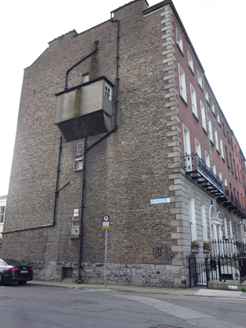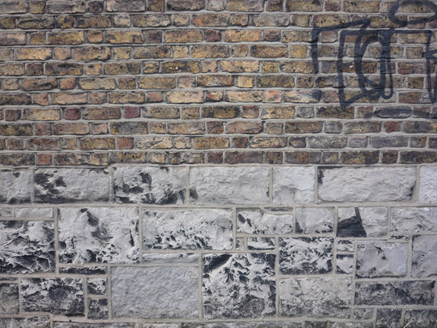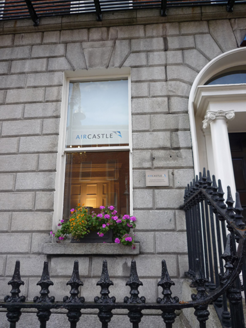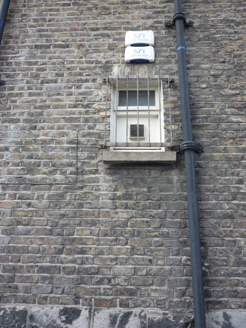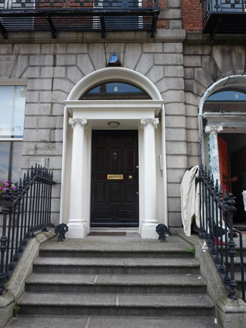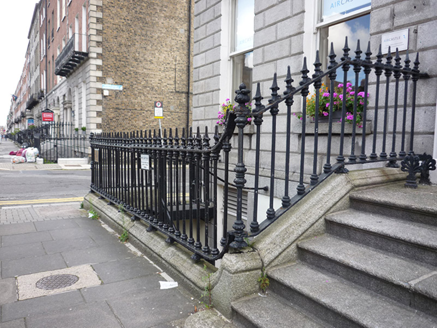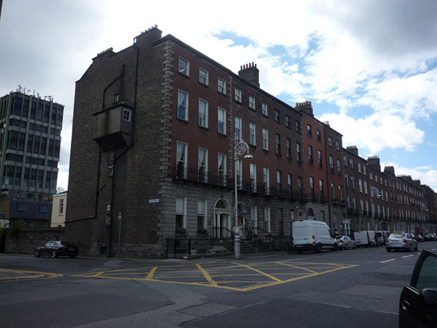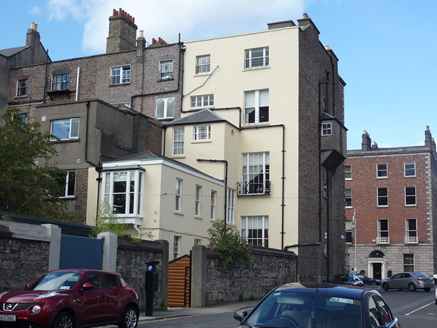Survey Data
Reg No
50930136
Rating
Regional
Categories of Special Interest
Architectural, Artistic
Original Use
House
In Use As
Office
Date
1815 - 1835
Coordinates
316514, 232907
Date Recorded
28/08/2015
Date Updated
--/--/--
Description
Corner-sited end-of-terrace three-bay four-storey over basement former townhouse, built c. 1825. Two-stage return to rear (east) and single-bay elevation to north fronting onto Cumberland Road, with sanitary out-shoot. Now in use as offices. M-profiled slate roof, hipped to south, concealed by ashlar granite parapet with moulded cornice and coping. Brick chimneystacks to north and rendered stack to centre of valley, with clay pots. Parapet gutters and cast-iron hoppers and downpipes to north elevation. Red brick walling laid in Flemish bond to principal (west) elevation, flanked by rusticated granite quoins, with rusticated ashlar granite walling to ground floor over ruled-and-lined rendered walling to basement beneath granite plinth course. Brown brick walling to north elevation, laid to English garden wall bond, over rock-faced random limestone plinth. Rendered walls to east (rear) elevation and return. Largely square-headed window openings with brick voussoirs, patent reveals and granite sills, with granite surround to basement openings. Plain surrounds to north and east elevations with cast-concrete sills to north. Largely replacement one-over-one sliding timber sashes with ogee horns, three-over-three to basement with convex horns. Diminutive timber windows to north elevation with cruciform casement to third floor, replacement sash to sanitary out-shoot and replacement casements to lower floors. Some Wyatt-style and replacement multi-paned timber sash windows to rear (east). Oriel window on profiled timber brackets to east elevation of return and tripartite opening with round-headed replacement sashes to north elevation. Continuous cast-iron balconette to first floor of west elevation. Wrought-iron guard rails to upper openings of rear (east) elevation and cast-iron balconette to first floor. Round-headed door opening to principal elevation (west) with moulded reveals and engaged Scamozzian-Ionic pilasters rising to prostyle portico with moulded cornice and plain frieze carried on matching columns, plain glass fanlight and replacement timber panelled door. Granite entrance platform with cast-iron boot scrapers, approached by six nosed granite steps, flanked by cast-iron railings with decorative finials and corner posts over carved granite plinth, enclosing basement well to north. Steel steps to basement well. Square-headed door opening to north side of basement well having granite surrounds and replacement timber door, plainly detailed door opening beneath entrance platform. Coal-hole cover to pavement. Squared-rubble limestone boundary wall lining north and east of rear plot, having raked rendered coping and pierced by vehicular openings with rendered piers and replacement timber gates. Two-storey mews building to east, converted for residential use, with M-profiled roof (hipped to north), rendered walls (east and west), rubble limestone north wall, replacement timber sash windows, single-storey flat-roofed extensions to east and west, pedestrian and vehicular openings having modern timber gates and ashlar stone surrounds, opening onto Cumberland Road.
Appraisal
Forming part of a similarly detailed group (Nos. 5-7, 50930133-5), this former townhouse retains a fine neo-classical doorcase and portico, rusticated granite walling to ground floor and decorative iron railings. Casey (2005) notes 'The interior of No. 8 is enlivened by arch and column screens (of Venetian window form) between the hall and stair hall and on the first return.' The house with its rusticated quoins frames, with No. 7, Cumberland Road. Developed in conjunction with the east and south sides of Fitzwilliam Square, the eastern side of Fitzwilliam Place was completed by 1836, with the exception of five houses to the south-end. Built in pairs or groups, the designs emulated those of Fitzwilliam Square South, but Casey notes that the interior ornament of Fitzwilliam Place is generally more varied and richer, particularly the internal stair halls.

